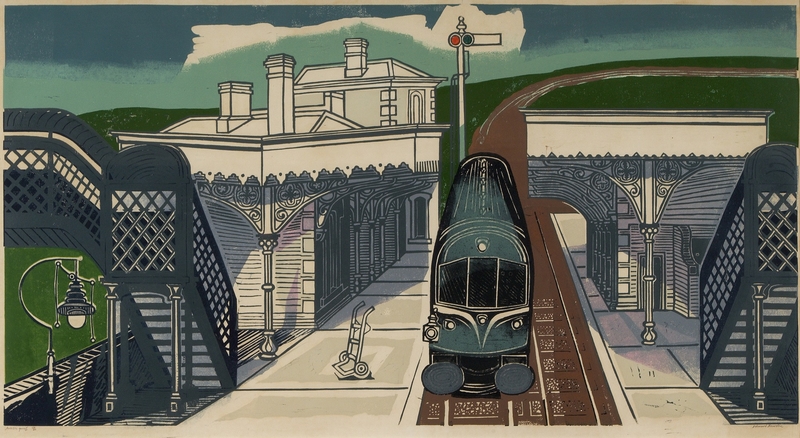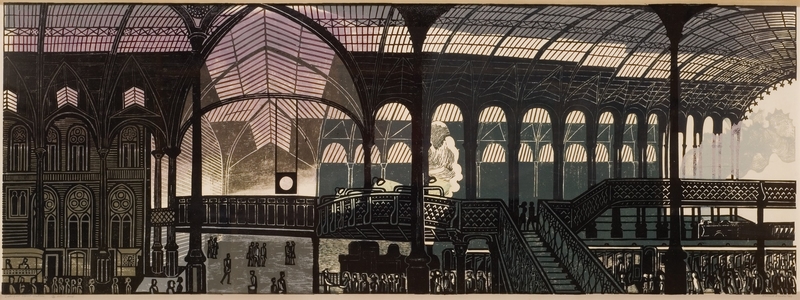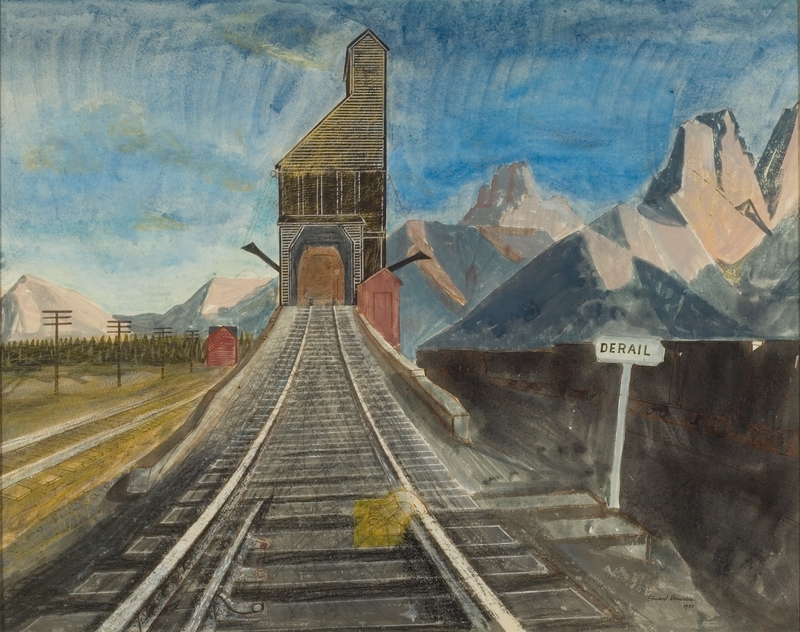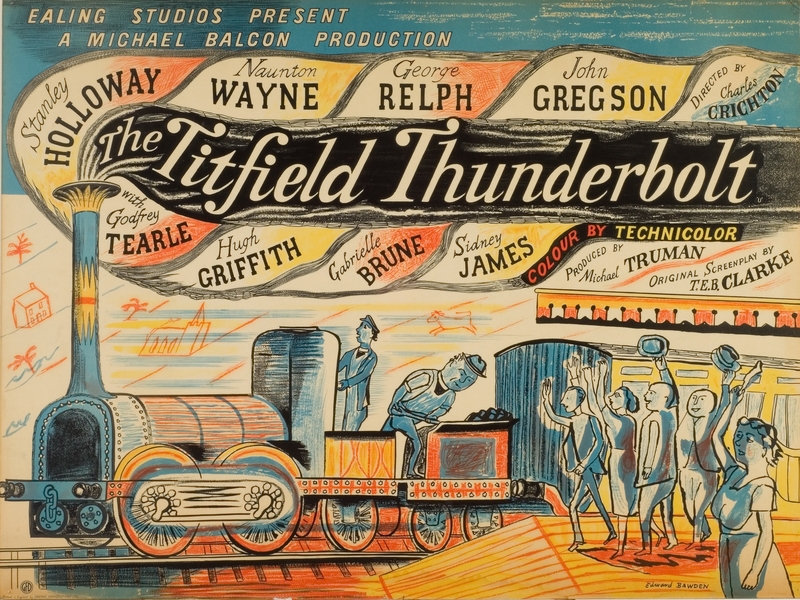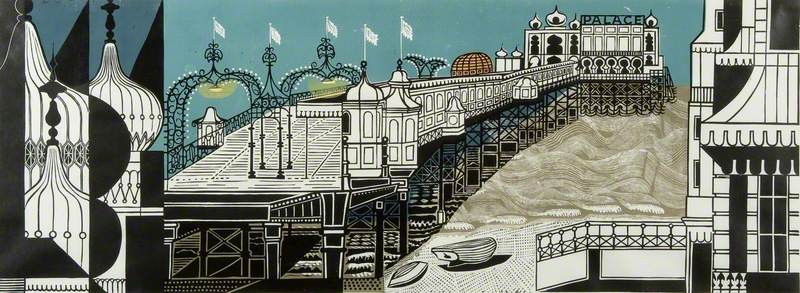To celebrate a new exhibition, ‘Edward Bawden: Trains, Planes & Automobiles’ at The Higgins Bedford, this curation looks at some of his most iconic train pictures. Between 1981 and his death in 1989 Bawden donated the contents of his studio, a gift of over 1,000 items, to the Cecil Higgins Art Gallery (now The Higgins Bedford). The collection includes work made whilst he was a student at the Royal College of Art in the 1920s right through to commissions he received in the 1980s.
Every year we put on a new exhibition drawn from this amazing collection. This newest exhibition explores how trains, planes, automobiles (and the occasional boat) are in so many of his works including well-known prints and advertising campaigns.
-
Braintree Station
Braintree Station 1960Bawden decided from a young age to be an illustrator after copying Louis Wain’s cats in The Girls Own Paper. After attending the Cambridge School of Art he was awarded a scholarship to study at the Design School of the Royal College of Art in Kensington, London. It would have been from this station in Braintree, Essex, in his home town, that he made the journey.
In 1960, when he made this work, he would still have been catching trains to London from Braintree as it was the nearest station to his home in Great Bardfield. The print is made in the same year as his large linocut Liverpool Street Station. Together they show the beginning and end of his journey.
Edward Bawden (1903–1989)
Linocut on paper
H 56 x W 106.3 cm
The Higgins Bedford
-
Liverpool Street Station
Liverpool Street Station 1960Bawden was so familiar with Liverpool Street Station that he described it as like an extension of his own house. His station is darker and sootier than todays, with steam trains still pulling into the station. His focus is not the trains, instead it is the huge iron and glass roof which he called ‘one of the wonders of London’ and which gave the station its nickname ‘The Dark Cathedral’.
Edward Bawden (1903–1989)
Linocut on paper
H 53.4 x W 146.1 cm
The Higgins Bedford
-
For large prints like Liverpool Street Station, that wouldn’t fit in the press in his studio, Bawden would have to shuffle over the paper with his feet to print each of the colours used. It was a long process; the blocks had to be heavily inked to make up for the loss of pressure and each inking would take a day to dry.
Peter Avery, Bawden’s assistant, wrote: ‘Mixing the proofing ink colours, inking up, laying the block on the floor, treading all over the print, dabbing out any faults, hanging each print in the drying rack (like an old fashioned laundry drying frame hauled up to the ceiling on pulleys) was physically demanding.’
-
To Winnipeg
To Winnipeg 1950Bawden spent two summers from 1949 in Alberta, Canada as a guest instructor at the Banff School of Fine Arts. He lived in a log cabin and adopted a uniform of double denim to stop the students mocking his English clothes.
Although he complained in letters home about mosquitoes and too many trees he produced several beautiful watercolours and used elements of the Canadian landscape in other aspects of his work.
Here Bawden is sitting directly on the track due to a train strike. His position is probably a short piece of track leading off the main line to a grain elevator.
Edward Bawden (1903–1989)
Watercolour, bodycolour, crayon, ink & cobblers wax on paper
H 56.6 x W 71.1 cm
The Higgins Bedford
-
The Titfield Thunderbolt
The Titfield Thunderbolt 1952The Titfield Thunderbolt was the second Ealing Comedy that Bawden was commissioned to design promotional material for. It was the studio’s first Technicolor comedy and told the story of a village community fighting to save their branch line from closure.
Ealing followed the example of companies such as Shell and London Transport in commissioning contemporary British artists to design posters for their films. Under the direction of the studios Head of Marketing, S. John Woods, posters were designed by the finest artist of the day including John Piper, Barnet Freedman and Edward Ardizzone.
Edward Bawden (1903–1989)
H 76 x W 101.7 cm
The Higgins Bedford
-
Bawden’s first commission for Ealing was for the 1947 film ‘Hue & Cry’. The film’s director, Charles Chrichton, had been so delighted with the result that Bawden was chosen for his next film ‘The Titfield Thunderbolt’ too.
Bawden worked from stills for both films was given free rein on the design. For The Titfield Thunderbolt he illustrated posters, press adverts, booklets and even a Christmas card all featuring the films eponymous hero.
The Edward Bawden Gallery at The Higgins Bedford Art Gallery & Museum
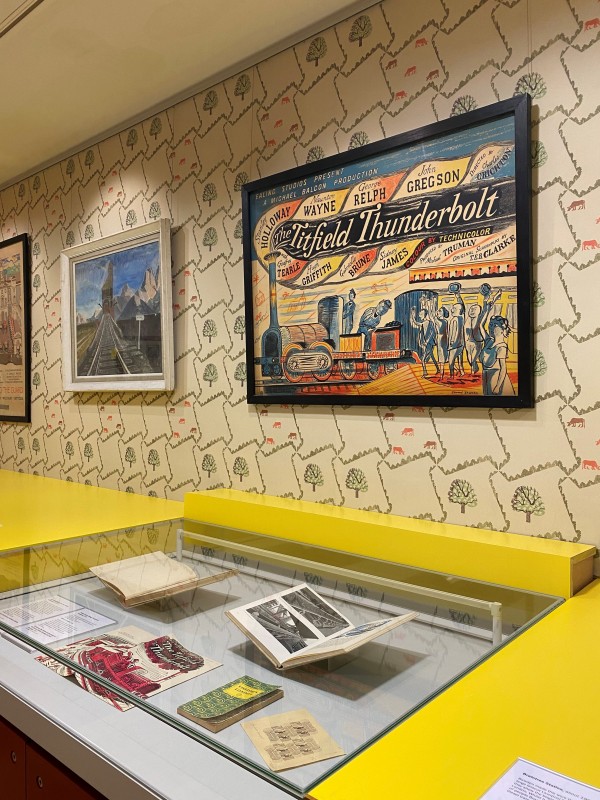 © The Higgins Bedford. Image credit: The Higgins Bedford
© The Higgins Bedford. Image credit: The Higgins Bedford
-
You can see these works and more in Bedford in this free exhibition until the 3rd March 2024. You’ll see his posters for London Transport, more advertising material for The Titfield Thunderbolt as well as lots of other forms of transport – hot air balloons floating over beaches, waving pilots in early biplanes, vicars driving through sheep and yapping dogs chasing anything with wheels.
The Higgins Bedford is open Tuesday to Saturdays 11am to 5pm and Sundays 2-5pm. For further details see website www.thehigginsbedford.org.uk
Exhibition Poster for Edward Bawden: Trains, Planes & Automobiles
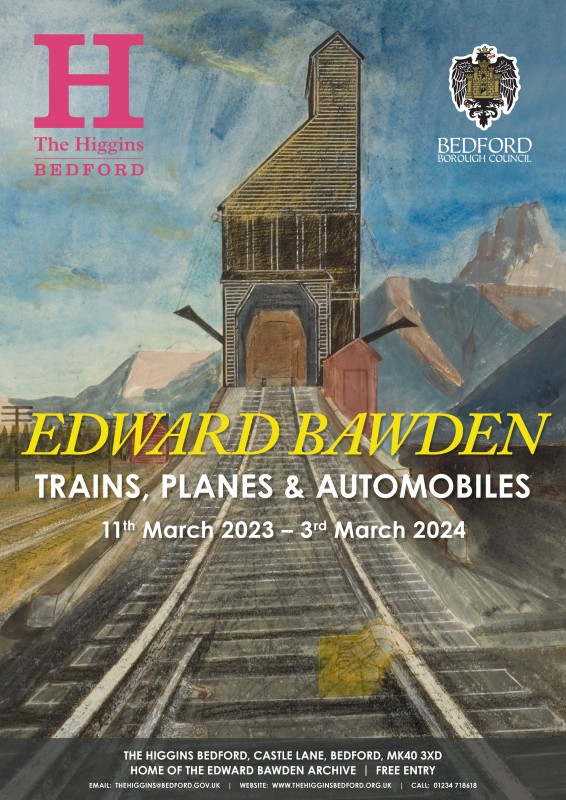 © The Higgins Bedford & The Estate of Edward Bawden. Image credit: The Higgins Bedford
© The Higgins Bedford & The Estate of Edward Bawden. Image credit: The Higgins Bedford
